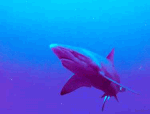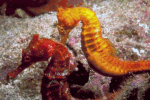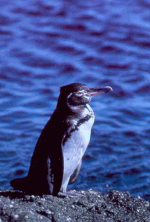by Mary L. Peachin with photography by Marc Bernardi and Mary L. Peachin
Nov 2000, Vol. 5 No. 2
 We clung to the barnacle-covered rocks of the seamount, sixty feet down, trying to avoid being swept away by the current. A shadow darkened the ocean above us, and our attention was diverted by an unparalleled underwater parade: Bottled-nosed dolphins escorting a 40-foot-long wide-mouth whale shark, its body gliding just below the surface toward the nearby Darwin’s Arch. The shark’s wide-open mouth scooped krill from the plankton-rich waters of the Galapagos, and dozens of remoras clung to the huge tailfin, all busy cleaning microorganisms from the animal’s huge polka-dotted hide. Below the dolphins’ entourage, schools of scalloped hammerheads swam in jigsaw patterns, their necks scarred by bites incurred during mating rituals.
We clung to the barnacle-covered rocks of the seamount, sixty feet down, trying to avoid being swept away by the current. A shadow darkened the ocean above us, and our attention was diverted by an unparalleled underwater parade: Bottled-nosed dolphins escorting a 40-foot-long wide-mouth whale shark, its body gliding just below the surface toward the nearby Darwin’s Arch. The shark’s wide-open mouth scooped krill from the plankton-rich waters of the Galapagos, and dozens of remoras clung to the huge tailfin, all busy cleaning microorganisms from the animal’s huge polka-dotted hide. Below the dolphins’ entourage, schools of scalloped hammerheads swam in jigsaw patterns, their necks scarred by bites incurred during mating rituals.
For the next five minutes, our group of fifteen divers watched in silence. I’d been diving for twenty years, and had never had such a thrilling underwater experience. Later, Allison, a fellow diver, commented, “A million Discovery Channel shows later, I’m in the midst of the real thing.”
 In the world of diving, our encounter could be compared to summiting a 6000-meter peak, skiing a double black diamond slope, or rafting a Class V river rapid. Our group—mostly techies from the San Francisco Bay Area—consisted of both intermediate and advanced divers, some with decades of experience, but none of us had seen anything like this. We ran into the whale shark again the next two mornings—plus dozens of schools of hammerheads, several solitary Galapagos sharks, and a white-tipped shark. We spotted eagle rays and the Pacific Tiger eel, admired colorful seahorses, or giggled as sea lions dive-bombed our bubbles—but nothing could equal the awe of that first sighting of the whale shark.
In the world of diving, our encounter could be compared to summiting a 6000-meter peak, skiing a double black diamond slope, or rafting a Class V river rapid. Our group—mostly techies from the San Francisco Bay Area—consisted of both intermediate and advanced divers, some with decades of experience, but none of us had seen anything like this. We ran into the whale shark again the next two mornings—plus dozens of schools of hammerheads, several solitary Galapagos sharks, and a white-tipped shark. We spotted eagle rays and the Pacific Tiger eel, admired colorful seahorses, or giggled as sea lions dive-bombed our bubbles—but nothing could equal the awe of that first sighting of the whale shark.
The site for our awe was the Pacific waters surrounding the northernmost Galapagos islands of Darwin and Wolf, 600 miles west of Ecuador. Surrounded by vertical cliffs that make landings inaccessible, the islands are visited primarily by divers, and considered one of the best dive sites in the world. Here the cold Humboldt and Cromwell currents blend with the warm Panama flow (aka El Niño) to provide a rich and diverse underwater world hosting 400 species of fish, 32 species of coral, and 600 kinds of mollusk.
 Most visitors come to the archipelago solely to observe the indigenous species, but dive magazines have recently rated the Galapagos one of the world’s best dive destinations. But diving here isn’t for beginners—cold water and strong currents make dives difficult. There’s also no guarantee that one will see whale sharks—in the five months prior to our visit, our divemaster, Galapagos naturalist Ruli Menoscal, had sighted them only twice. He explained, “In the Galapagos, the conditions are so variable that diving and currents are never the same. There is no guarantee, ever.”
Most visitors come to the archipelago solely to observe the indigenous species, but dive magazines have recently rated the Galapagos one of the world’s best dive destinations. But diving here isn’t for beginners—cold water and strong currents make dives difficult. There’s also no guarantee that one will see whale sharks—in the five months prior to our visit, our divemaster, Galapagos naturalist Ruli Menoscal, had sighted them only twice. He explained, “In the Galapagos, the conditions are so variable that diving and currents are never the same. There is no guarantee, ever.”
It wasn’t easy to get where we were going. After a 16-hour, 60-mile overnight cruise, our captain sounded the ship’s horn signaling our arrival at the equator. Our dive boat, the 97-foot yacht Reina Silvia, anchored in the lee of the cliffs of Darwin’s Island, a rookery for red-footed and masked boobies, albatross, and swallow-tailed gulls. Three times a day we divided into three dinghies for the 15-minute boat ride to the Arch. Spinner dolphins followed us, spinning in the surf and doing loops in the air. It was better than a show at Sea World.
 Our boat was almost as impressive. Endowed with twin 400-hp diesel engines, 250-kilowatt generators, and a desalination machine that cleans 60 gallons of water per hour (not to mention a satellite cell phone, charging $36 for a 10-minute call), the Reina Silvia is owned by Ralph Sievers, who lives in Puerto Ayora. The yacht, named in honor of his friend, the Queen of Sweden, had a lounging deck where we dressed for diving, a dive deck where we boarded the dinghies, a dining room and salon, and eight double-deck cabins carrying a total of 16 divers. A crew of eight aided Captain Jacinto Jamarillo. They included two mates, Julio and Panchito, and three dinghy drivers, Juanito, Pancho, and David. We soon got to know Elvis, the spiffily dressed bartender, and Patricio, the chef, who saw that we were continually well fed.
Our boat was almost as impressive. Endowed with twin 400-hp diesel engines, 250-kilowatt generators, and a desalination machine that cleans 60 gallons of water per hour (not to mention a satellite cell phone, charging $36 for a 10-minute call), the Reina Silvia is owned by Ralph Sievers, who lives in Puerto Ayora. The yacht, named in honor of his friend, the Queen of Sweden, had a lounging deck where we dressed for diving, a dive deck where we boarded the dinghies, a dining room and salon, and eight double-deck cabins carrying a total of 16 divers. A crew of eight aided Captain Jacinto Jamarillo. They included two mates, Julio and Panchito, and three dinghy drivers, Juanito, Pancho, and David. We soon got to know Elvis, the spiffily dressed bartender, and Patricio, the chef, who saw that we were continually well fed.
En route to our first dive site, Ruli gave us a briefing before we tackled the waters around the dramatic arch: “It might be rock-and-roll conditions; the current can run as strong as five knots. Don’t turn your head against it; you might lose your dive mask.”
We looked around at each other as Ruli continued. “When we back-roll off the dingies, don’t surface. Descend immediately to the rocks or abort the dive to avoid being carried by the current into the blue ocean. Find a rock and stay there—just hang out and watch the sharks. Try to control your bubbles; the hammerheads are afraid of them. The barnacles on the rocks provide good handholds, but beware—they’ll nip at you. Avoid the spiny sea urchins. And keep an eye on the moray eels; they’re not aggressive, but do have a nasty bite when threatened.” In short, this was not a dive for the inexperienced. Throughout our three days of diving, the currents were uniformly swift; whenever we surfaced we seemed to fly away with the current.
 We saw the whale shark three times at Darwin’s Arch, often accompanied by hammerheads, which were themselves enveloped by schools of small, reddish creole fish. The sights were so good that the group decided to forego our next destination, Wolf Island, hoping for another sighting. On one dive we saw two 12-foot Galapagos sharks and a large bottlenose dolphin.
We saw the whale shark three times at Darwin’s Arch, often accompanied by hammerheads, which were themselves enveloped by schools of small, reddish creole fish. The sights were so good that the group decided to forego our next destination, Wolf Island, hoping for another sighting. On one dive we saw two 12-foot Galapagos sharks and a large bottlenose dolphin.
There were numerous exciting encounters. As Ruli and I ascended from one dive, trying to control our speed while being swept by the current, a Galapagos shark circled us. Thankfully, the shark lost interest in us as we surfaced to three-foot swells. On another dive, Jay and Don saw a sailfish, sail unfurled, as they waited on the surface for the dinghy. And Sophie and Dave ascended into a pod of dolphins.
When we returned to the yacht, red-footed boobies cuddled along the anchor line and the rails of the bow, undaunted by the plastic garbage we’d tied on to deter them. One of the brazen birds hovered over the bow with a toothbrush, swiped from the sundeck, in its beak.
 While focused on the marine life, we didn’t miss the opportunity to visit the indigenous species made famous by Charles Darwin. Ruli led us along the lava-rock path of Isla North Seymour, one of the more popular nature walks. Male blue-footed boobies performed a mating dance, kicking their turquoise feet in a display called “sky pointing” and whistling to the females. Many of the birds had chicks that appeared to be three or four months old.
While focused on the marine life, we didn’t miss the opportunity to visit the indigenous species made famous by Charles Darwin. Ruli led us along the lava-rock path of Isla North Seymour, one of the more popular nature walks. Male blue-footed boobies performed a mating dance, kicking their turquoise feet in a display called “sky pointing” and whistling to the females. Many of the birds had chicks that appeared to be three or four months old.
Magnificent frigate birds, the males with a purple sheen, nested on the salt bush. Some put on a great sexual display, inflating their red gullets like balloons. We also saw the greenish-black great frigate, surrounded by several large, white-headed chicks. Black marine iguanas sunned on the rocks, and red Sally Lightfoot crabs scurried along the shore, next to swallow-tailed gulls.
 On another trip we visited Isla Rabida, where a bull sea lion dominated the half-mile iron-red beach. The island, covered in black mangroves, sea grass, and the occasional opuntia prickly-pear cactus, featured a brackish lagoon that, before El Niño’s warmth severely diminished the population, hosted pink flamingos and even more sea lions.
On another trip we visited Isla Rabida, where a bull sea lion dominated the half-mile iron-red beach. The island, covered in black mangroves, sea grass, and the occasional opuntia prickly-pear cactus, featured a brackish lagoon that, before El Niño’s warmth severely diminished the population, hosted pink flamingos and even more sea lions.
Along Isla Santiago’s St. James Bay, we walked among lava-covered tidal pools, observing marine iguanas sunning themselves on the rugged rocks. Lava herons eyed Sally Lightfoot crabs and a great blue heron stood lazily on one leg near a blowhole known as Darwin’s Toilet. Seals hung out in an underwater arch near the tide line, where two American oystercatchers guarded their chick. Walking back along the high trail, we encountered some other tourists eyeing a Galapagos snake. As we cast off in our dinghy, a bull sea lion sneezed, the deep rolling sound carrying over the water.
 After three days in Darwin, we returned to the Bay of Bartolome, where we snorkeled with the Galapagos penguins, relatives of the Magellan variety found in southern Chile. We then made our final land visit, to the port town Puerto Ayora (population 6000) on the island of Santa Cruz. After viewing the Darwin Research station, where scientists study the giant tortoise, we took a bus ride into the tropical humid zone of the highlands, to an elevation of 1900 feet. We hiked through moss-covered escalesia tree forest to view two million-year-old sinkholes called “The Twins.” Ferns covered the walls of both sinkholes, which were inhabited by Darwin finches, vermilion flycatchers, and Galapagos doves. We concluded by walking a mile through a dimly lit, dripping lava tunnel about twenty feet underground, emerging into the riotous ecosystem that is the Galapagos.
After three days in Darwin, we returned to the Bay of Bartolome, where we snorkeled with the Galapagos penguins, relatives of the Magellan variety found in southern Chile. We then made our final land visit, to the port town Puerto Ayora (population 6000) on the island of Santa Cruz. After viewing the Darwin Research station, where scientists study the giant tortoise, we took a bus ride into the tropical humid zone of the highlands, to an elevation of 1900 feet. We hiked through moss-covered escalesia tree forest to view two million-year-old sinkholes called “The Twins.” Ferns covered the walls of both sinkholes, which were inhabited by Darwin finches, vermilion flycatchers, and Galapagos doves. We concluded by walking a mile through a dimly lit, dripping lava tunnel about twenty feet underground, emerging into the riotous ecosystem that is the Galapagos.
 The Galapagos is a great destination for anyone interesting in viewing the endemic species. For the experienced scuba diver, it offers world-class diving with numerous schools of hammerheads. And there is always the lucky few who will have an underwater encounter with the magnificent whale shark.
The Galapagos is a great destination for anyone interesting in viewing the endemic species. For the experienced scuba diver, it offers world-class diving with numerous schools of hammerheads. And there is always the lucky few who will have an underwater encounter with the magnificent whale shark.
If you go:
Air service: American Airlines flies non-stop twice daily to Quito, Ecuador. The high valley airport, surrounded by the Andes, is sometimes closed by fog; in that case, flights are diverted to the city of Quayaquil. Allow an extra day on each end of your trip to make connections to and from the Galapagos.
Visa: A U.S. passport is required; visas are issued on arrival.
Language: Spanish, although many speak English
Quito: Located near the equator, the city is surrounded by interesting Inca archeological sites, the Cuenca Indian market of Otavalo, and the volcanic peaks of Cotapaxi to the south. Some tourists also use Quito as a gateway to the Napo River and the headwaters of the Amazon. The weather hovers around 70 degrees. Prices for hotels and restaurants are very reasonable. The U.S. dollar, rather than the sucre, is used as an inflationary measure.
Quito hotels:
Alameda Real: Fax 011-593-2-565759 or e-mail [email protected] Hacienda Cusin: Fax 011-593-6-918003 or e-mail [email protected] or go to www.haciendacusin.com
Flights to the Galapagos: Tame Airlines provides twice-daily service to Baltra in the Galapagos through Guayaquil.
Diving: The Galapagos is for experienced divers only. The water is about 72-78 degrees; currents are strong and unpredictable. Wetsuits and gloves are a necessity. Aquatic Encounters: go to www.aquaticencounters.com or call 1-800-7575-1365 x1815
Tours: www.ecoventura.com
